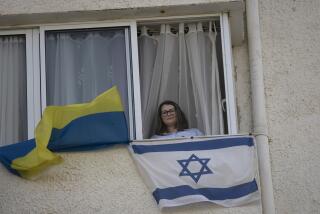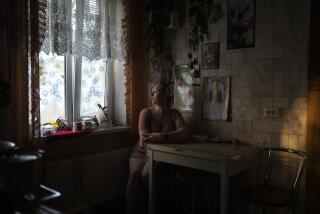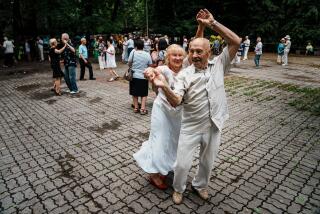First Report by Western Newsmen : Disaster Zone Refugees Take Uprooting Stoically
- Share via
KOPELOVO, Soviet Union — The following story is based on a pooled report filed by the first Western reporters allowed to go to Kiev since the Chernobyl nuclear power plant accident. The English-language press was represented by Reuters.
“I took some things, two or three little blankets and pillows,” said 80-year-old Marina Ilchenko, who was evacuated from the area of the Chernobyl nuclear disaster and temporarily housed at this state farm.
“We had to leave our dog,” she said.
Ilchenko, interviewed today, was in the second wave of those moved from the vicinity of the April 26 nuclear accident that sent a cloud of radioactivity over Europe and portions of the Soviet Union.
The numbers of the evacuees eventually reached 84,000 people and 34,000 head of livestock, officials told the first group of foreign reporters allowed into the area since the accident.
Those evacuated were said to be staying in hundreds of Ukrainian villages like this one, sharing homes and worker dormitory rooms with local residents.
Avoid ‘Danger Zone’
The journalists were not taken near the disaster site, 60 miles north of Kiev. Nor did they approach the “danger zone” area of radioactivity in an 18-mile radius of the plant.
“There’s no point in going to the zone,” said Ivan Plyusch, a local government official for a region that includes Chernobyl. “Just empty countryside.”
Kopelovo, 31 miles west of Kiev, took in 1,060 people evacuated from the Opachichi collective farm, which is 17 miles from the crippled reactor.
The Opachichi residents were told on May 2, six days after the accident, that they had to leave with their livestock. Ukrainian authorities said that at first the scope of the disaster was underestimated.
“They came and explained on Friday (May 2) and took us here,” Ilchenko said. “We had just built a new home,” she said. Then she started weeping.
An 18-year-old girl named Antonia said that she knew there had been an explosion at the plant but that she could not believe the dimensions of the accident were so great. “If the radiation had been strong, they would have taken us away,” she said.
“We’ve been evacuated before,” an old woman said, alluding to upheavals during Nazi Germany’s invasion during World War II.
The Kopelovo state farm’s hairdressing shop has been turned into a makeshift clinic, with technicians taking blood samples from evacuees. Orderlies in white coats and army boots were checking peasants for radiation nearby at an army tent put up in the shade of a chestnut tree.
Dr. Ivan Vishnevsky said that so far three of the evacuees from Opachichi were ordered hospitalized because of high radiation exposure.
‘What Can We Do?’
Those who spoke with reporters seemed concerned. “We have thought about it, but what can we do about it?” Antonia said.
Plyusch said life in the danger region had been normal immediately after the accident because the full consequences were not understood. “When I got there,” he said, “people were fine. There were still weddings going on.”
He said that when it was decided to evacuate the first wave, from within six miles of the reactor, “We told people they were going for a few days. We told them they could take their dogs and pets.”
Asked how long the danger zone will be closed, Plyusch said, “If I knew it, I would tell you.”
More to Read
Sign up for Essential California
The most important California stories and recommendations in your inbox every morning.
You may occasionally receive promotional content from the Los Angeles Times.













